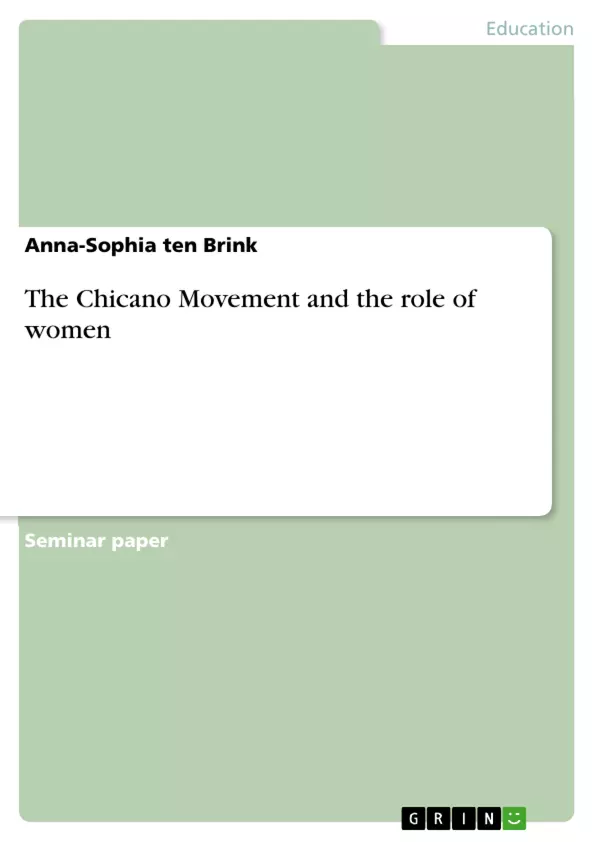The 1960's and 1970's were critical years for the Latino community across the United States. Spanish-speaking people from the east to the west coast were engaged in groundbreaking civil-rights efforts during these decades. These efforts, which were built on earlier struggles of Latino and Latina activists since the end of the Mexican-American war in 1848 (cf. Escobar 1993), established a new factor in U.S. society and race relations. Hard work was put in to achieve those goals. The most challenging region of Latino activism during this era was southern California. In Los Angeles, Mexican-Americans had to face severe discrimination, segregation and racism.
Therefore, some of the most important events in the Chicano community occurred in Los Angeles; the Chicano Blowouts, the Chicano Moratorium and the Chicana women rights movement, also known as the Chicana Feminist Movement. All three fuelled a national movement, that would forever change the face of Latino identity and politics in America (cf. Trevino 2001). Having Mexican ancestry during that time was not considered as something to be proud of, people with Mexican heritage were not treated as equals by the white population in the United States, therefore it was just a question of time until some sort of movement would break out. This paper will focus on Chicana women and Chicana feminism, with a closer look at how the Chicano Movement dealt with Mexican-American women. Another point of particular interest is if and how Chicanas influenced the Chicano Movement and how they dealt with each other and finally the investigation of the role of Chicana women within the Chicano/Chicana Movement, their traditional role and the later change to the modern role, within the Chicano community and within American society. To be able to answer these questions, one at first has to take a closer look at the Chicano Movement itself. The first chapter introduces the Chicano Movement in general, explains terms and definitions, the second chapter focuses on major events during the movement, the third chapter deals with the leaders of the movement and the last chapter with Chicana women, feminism, their role during the Chicano Movement and their position within society back then and nowadays. The paper ends with a functional conclusion.
Table of Contents
- Introduction
- Definition
- Chicano/Chicana
- Chicanismo
- The Chicano Movement
- Major events during the Movement
- Student Walkouts
- Groups and organizations
- Anti-war activism
- Strikes
- Leaders of the Movement
- César Chávez
- Reies López Tijerina
- Rodolfo “Corky” Gonzales
- Dolores Huerta
- Chicana women within the Chicano/a Movement
- How the Chicano Movement dealt with women
- Chicana Feminism
- The Chicana Feminist Movement
- Chicana women within the Chicano culture and society
- Chicana women nowadays
- Conclusion
Objectives and Key Themes
This paper aims to provide an in-depth analysis of the role of Chicana women within the Chicano Movement. It examines how the movement addressed the concerns of Mexican-American women, the development of Chicana feminism, and the impact of Chicana women on both the Chicano culture and American society. Furthermore, the paper explores the evolution of the traditional role of Chicana women within the Chicano community towards a more modern role.
- The Chicano Movement and its historical context
- The emergence of Chicana feminism
- The impact of Chicana women on the Chicano Movement
- The role of Chicana women in Chicano culture and society
- The evolution of the role of Chicana women in modern society
Chapter Summaries
The first chapter introduces the Chicano Movement, defining key terms and concepts such as Chicano/Chicana, Chicanismo, and the Chicano Movement itself. It provides a historical overview of the movement, highlighting its roots in earlier struggles for civil rights and its rise in the 1960s and 1970s. The second chapter focuses on major events during the movement, such as student walkouts, the formation of groups and organizations, anti-war activism, and strikes. This chapter explores how these events contributed to the movement’s growth and its impact on the Chicano community.
The third chapter delves into the leadership of the Chicano Movement, highlighting the key figures who played significant roles in shaping its direction and ideology. This includes individuals like César Chávez, Reies López Tijerina, Rodolfo “Corky” Gonzales, and Dolores Huerta, who spearheaded various initiatives and efforts to achieve social justice for Chicanos.
The fourth chapter focuses on the role of Chicana women within the Chicano/a Movement. It examines how the movement addressed the specific concerns of Mexican-American women and the development of Chicana feminism. This chapter explores the experiences of Chicana women within the movement and their contribution to its success.
Keywords
This paper examines the Chicano Movement, Chicana feminism, Mexican-American women, civil rights, social justice, ethnic identity, cultural affirmation, and the evolution of the role of Chicana women in modern society. The paper explores the impact of the movement on Chicano culture, society, and politics, with particular emphasis on the experiences and contributions of Chicana women.
- Quote paper
- Anna-Sophia ten Brink (Author), 2017, The Chicano Movement and the role of women, Munich, GRIN Verlag, https://www.grin.com/document/583460



